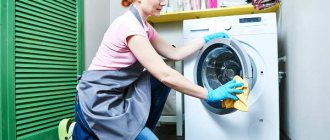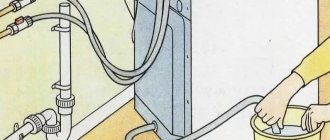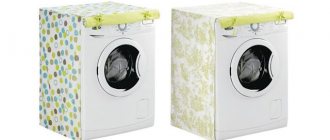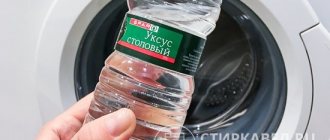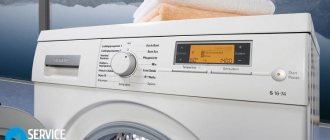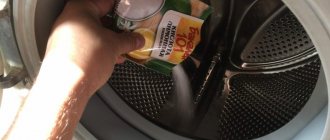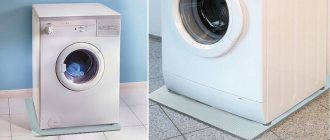The Samsung washing machine is considered one of the most reliable and convenient.
It is not difficult to master the operation of a household appliance if you carefully read the instructions and understand the rules. Firstly, the new unit must be properly prepared for operation.
Further, in order to successfully use the machine, it is recommended to choose the correct washing mode, observe loading standards, and fulfill all care requirements after finishing the operation of the device.
Let's take a closer look at how to properly use a Samsung washing machine.
Life time
The service life of Samsung washing machines is about 8-10 years, but these data are averaged.
How long the device will work is influenced by the activity of its operation, the quality of the detergents used, the degree of water hardness, assembly features, and the absence of manufacturing defects.
The features of using the device are important. If a person regularly violates the rules of the instructions and overloads the machine, then it will fail faster.
In accordance with GOST 8051-83 standards, the average service life of washing machines must be at least 15 years or 700 hours of operation. However, in fact, there are very few such devices on the market.
Design Features
from Samsung - a honeycomb drum, the holes of which are smaller compared to models from other manufacturers. They are placed in peculiar faceted recesses, and in some models the rows of recesses are arranged in a wave-like manner.
This design prevents fabric fibers from being pulled out during the washing process and allows the laundry to easily slide along the walls of the drum and not tangle. The washed item has no snags, pilling or other damage.
A standard Samsung washing machine with Eco Bubble is equipped with a reliable ceramic heater that does not form scale (the manufacturer claims trouble-free operation of this element for 10 years) and a surge protection system (safe operation within 165-275 V) .
In case of a sharp surge (up to 400 V), the system ensures that the washing cycle is suspended and resumed after the network voltage has stabilized.
Most consumers claim that the weight of the machine is too large, especially considering its compact dimensions, about 63 kg. This is despite the fact that the mass of most models of modern washing machines is 56-60 kg. The difference is small, but nevertheless it exists.
However, this is not at all a reason to say a decisive “no” to the purchase. As for the management, most people are completely delighted. Switching modes is done simply by turning the wheel.
The machine has a classic front-loading system. Most users prefer this type of laundry load. An undoubted advantage is that the car has electronic control.
Important! The instructions for Samsung Eco Bubble 6 kg make it easy to understand the controls. The machine is equipped with a timer and an electronic display, which makes it possible to monitor washing parameters.
Loading volume A drum designed for 6 kg of laundry is considered optimal by many buyers. However, in the Samsung Eco Bubble line there are models designed for 8 kg.
Important! It should be taken into account that many washing devices with the same load volume, compared to the Samsung Eco Bubble 6 kg, are not nearly as compact.
Models
WW6600R
WW6600R is one of the cheapest models with a maximum load of 7 kg. Thanks to the Bixby feature, the consumer has the ability to control the device remotely. There is a built-in quick wash mode that will complete the entire process in 49 minutes. Thanks to the vortex structure of the Swirl+ drum, the number of revolutions increases. A special AquaProtect sensor is built in, which will prevent water leakage. The Eco Drum function helps eliminate various unpleasant odors that can be caused by dirt or bacteria. In case of severe contamination, the user will see a corresponding message on the electronic display.
Another equally important technology is the steam cleaning system. It ends up at the bottom of the drum where the clothes are. Thanks to this, impurities are cleaned and substances that can cause allergies are removed.
To ensure that detergent is rinsed out more efficiently after washing, the Super Rinse+ mode is provided.
Thanks to this, impurities are cleaned and substances that can cause allergies are removed. To ensure that the detergent is rinsed out more efficiently after washing, the Super Rinse+ mode is provided.
To be calm about the safety of this machine, the manufacturer has built in surge protection and the ability to quickly diagnose. Level A washing quality class, the presence of an inverter quiet motor, which during operation produces 53 dB during washing and 74 dB during spinning. Operating modes include delicate wash, super rinse+, steam, economical Eco, washing synthetics, wool, cotton and many other types of fabric. The volume of water consumed per cycle is 42 liters, depth – 45 cm, weight – 58 kg. The electronic display has built-in LED backlighting. Electricity consumption – 0.91 kW/h, energy efficiency class – A.
WD5500K
WD5500K is a mid-price segment model with a maximum load of 8 kg. Its distinctive feature is its unusual metallic color and narrow shape, which allows this model to be placed in small openings where other cars cannot fit. Another feature is the presence of Air Wash technology. Its purpose is to disinfect clothes and linens using hot air streams, thereby giving them a smell of freshness and disinfecting them from bacteria. The fight against germs and allergens is carried out by a function called Hygiene Steam, which works by delivering steam to the clothes from the bottom compartment of the drum.
The basis of all work is a powerful inverter motor, which saves energy and at the same time operates quite quietly. The difference from the previous model is the presence of such a function as VRT Plus. It significantly reduces noise and vibration levels even when operating at the highest drum speeds. In addition, a special vibration sensor is built in, which balances the entire structure. This washing machine uses a combination of quick wash and dry modes. The whole process takes 59 minutes, after which you will receive clean clothes that are completely ready for ironing. If you just want to dry your clothes, then the load should not exceed 5 kg.
If we talk about characteristics, then the noise level is 56 dB for washing, 62 dB for drying and 75 dB for spinning.
WW6800M
WW6800M is one of the most expensive and efficient washing machines from Samsung. This model has improved characteristics when compared with previous copies. The main feature is the presence of QuickDrive technology, which is aimed at reducing washing time and reducing energy consumption. There is also a built-in AddWash function, which allows you to place clothes in the drum in cases where you forgot to do this in advance. It is worth saying that you can take advantage of this opportunity even after the wash has started. This model has a set of functions for diagnostics and control over the quality of work.
Thanks to the QuickDrive and Super Speed functions, washing time can reach up to 39 minutes. It should be noted that this model has a whole system for cleaning clothes and washing machine components. There are also functions to reduce noise and vibration during operation. The load is 9 kg, energy efficiency and washing quality class is A.
We carefully select the program
Modern Samsung models offer a dozen different washing programs. With one button you can quickly and effortlessly select the optimal spin and temperature for your laundry, without worrying about the result. But in order to choose the right mode, you need to understand the characteristics of each.
- Cotton. One of the longest and highest temperature programs designed for dense and natural materials.
- Synthetics. It is selected for fabrics that shed and easily deform, so the temperature is set to medium and the spin to minimum.
- Kids clothes. Characterized by high temperature and copious rinsing.
The “Children’s” program is suitable not only for washing children’s clothes, but also for caring for the things of allergy sufferers.
- Wool. Low temperature and minimal spin - what is required for woolen products.
- Intense. Helps get rid of old and difficult to remove stains.
- Fast 29. Lasts only 30 minutes, so it does not cope with heavy soiling, but only refreshes things.
- Spin. Allows you to repeat the spinning of the drum and dry your clothes more quickly.
- Economical. Due to the lower temperature and the elimination of rinsing, the machine uses less resources.
- Preliminary. First, things are soaked, and then the standard cycle automatically starts.
- Rinse plus spin. The mode offers you to quickly refresh things, which will take no more than 20 minutes.
- Jeans. The program is designed for denim and prevents jeans from losing color.
- Delicate. A universal program suitable for all thin and fragile fabrics.
- Outerwear. Special program for washing down jackets, jackets and sports items.
Detailed characteristics of the modes available on the Samsung washing machine are given in the factory instructions of the machine.
More expensive washing machines may have additional functionality. Thus, many cars have an “Active Sports” mode, during which things are cleaned of sweat, grass, soil and other typical “sports” contaminants. The “Hygiene” program is aimed at fighting fat and blood, and the “Kitchen” program is good against oil, berries and fish . For washing paints, felt-tip pens and ink, there is a “Moveable children” key.
Common breakdowns
Most often, the following elements fail in Samsung washing machines:
- heating element. If it burns out, it needs to be replaced.
- Drive belt. In the vast majority of cases, it simply wears out during use. The belt cannot be repaired and must be replaced.
- Inlet valves. If they are clogged, they need to be cleaned.
- Drain pump, seals and bearings. Most often, repairs come down to replacing parts.
This section will tell you about repairing Samsung washing machines.
Error codes
If any element fails, the smart technology independently determines this and issues a characteristic error code. The most common of them:
- 1E – failure of the pressure switch;
- 3E, 3E1 – the tachometer is broken;
- 4E, 4E1 – there is no water in the tank;
- 5E – problem in the drainage system;
- 8E – motor failure;
- 9E1, Uc - power problems;
- CE – water overheating;
- HE, HE1, HE2 – failure of the heating element;
- LE – water leak;
- OE – tank is full of water;
- tE1, tE2, tE3 – thermal sensor failure;
- Sud – excess foam.
All error codes are discussed in this section.
How to disable Indesit?
The methods of resetting the settings discussed above are universal. But there are special cases characteristic of certain models. Some are not equipped with a “start/pause” button; for others, the developers have come up with a special algorithm of actions. Let's figure out how to act as owners of SMA "Indesit".
To turn on the washing, turn the control toggle switch and, having set the appropriate mode, press the button with a diamond. Procedure:
- Click on the diamond. Don't let go for 5-6 seconds.
- If the machine is working properly, the current settings will be reset.
- On outdated versions, you should perform one more action - set the toggle switch to neutral.
What is the Eco Bubble function?
All housewives know that washing clothes with rich foam is much easier than with a solution of washing powder. This feature was adopted by engineers. The new machine has a special compartment (foam generator), in which water, washing powder and air are thoroughly mixed. The foam formed in it enters the tank with the laundry and gently washes it. It penetrates into fibers 40 times faster than any powder solution. This new feature is called “Eco Bubble”. In addition to improving the quality of washing, it also allows you to save a lot on electricity. The fact is that when using foam, the temperature of the water in the tank can be significantly reduced. Why won't this affect the quality of the wash?
Any Samsung model washes clothes efficiently. The Eco Bubble washing machine also has the advantage that when using it, the procedure for rinsing clothes is greatly simplified. After all, it is much easier to remove foam from it than powder.
Do I need to add detergent?
There are several recommendations to follow when choosing a detergent for the first launch:
- If ordinary washing powder is poured into the powder receptacle, it is important that the package is marked “automatic”.
The thing is that hand washing powders are characterized by increased foaming, which can lead to damage to the household appliance. - As an option, you can use a special product that effectively removes technical dirt and foreign odors - Helfer Start HLR0054.
For the first launch, one package of this tool is enough. It is poured into the powder receptacle in the main wash compartment.
For the first test wash, use a minimum amount of regular washing powder (less than half the norm).
Precautionary measures
- Image
- Text
10_ precautions
EXPLOSIVE GAS. If your hot water system has not been used for
two weeks or more, open all hot water taps in your home and let
let the water drain for a few minutes before using the washing machine
by car. This will allow all the hydrogen produced to escape. At this time you should not
Smoking and lighting open fires, as hydrogen is flammable. If there is a leak
gas, ventilate the room immediately without touching the power plug. Do not climb on or place things on the machine (such as laundry, lighted candles,
outstanding cigarettes, dishes, chemicals, metal objects, etc.).
— This may result in electric shock, fire, machine failure, or personal injury. Do not spray volatile substances, such as insecticides, on the surface
cars.
- In addition to being harmful to people, they can also cause stroke
electric shock, fire or machine breakdown.
Do not place devices that create electromagnetic emissions near the washing machine.
fields.
— This may result in injury due to machine malfunction. Since the water drained during washing and drying is at a high temperature, it is not
allow contact with this water.
— This may cause burns or injury. Do not wash, wring or dry waterproof seat covers.
mats or clothes (*) if your machine does not have a special washing program
these things.
— Do not wash thick, hard mats.
— Doing so may cause injury or damage the washing machine, walls, floor, or
clothing due to excessive vibration.
* Wool bedding, rain covers, fishing vests,
ski pants, sleeping bags, baby diapers, sports jerseys
suits, as well as awnings for covering bicycles, motorcycles, cars, etc.
Do not operate the machine unless the detergent box is in place.
place.
— This may result in electric shock or injury due to water leakage. Do not touch the inside of the tank during or immediately after drying as
she's hot.
- This may cause burns. Do not put your hand in the detergent box after you open it.
— This may cause injury as your hand may be caught
data input device for detergents. Do not put in washing machine
no objects (such as shoes, leftover food, animals) other than those that
washable.
— Due to strong vibration, this may cause damage to the washing machine or
injury and death of pets.
Do not press the buttons with sharp objects such as hairpins, knives, nails, etc.
— This may result in electric shock or injury. Do not wash laundry contaminated with oils, creams or lotions that are commonly
sold in specialty stores that sell skin care products, or in
massage clinics.
— This may cause spontaneous combustion or fire due to high
temperature that is created during the oxidation of oil.
Do not use hot water from water cooling/heating devices.
— This may cause problems with the washing machine. Do not use natural hand soap in the washing machine.
— If it hardens and accumulates in the washing machine, it may cause
problems with it, discoloration, the appearance of rust or unpleasant odors.
Do not wash large items, such as bedding, in a laundry net.
— Place socks and bras in a laundry net and wash them with other laundry.
— Failure to do so may result in injury due to strong vibrations.
precautionary measures
WF8590NM-02796G-10_EN.indd 10
2013-12-12 11:55:59
Comments
Select → I found the instructions for my washing machine here! #manualza
Click →
The brain of each of us is like a miracle mechanism. Only most have instructions for it in Chinese.
Manualza!manualza.ru
Video
Below is a video on the topic of our article.
Mom, wife and just a happy woman. She draws inspiration from travel and cannot imagine life without books and good films. She strives to become an ideal housewife and is always ready to share her experience.
Found a mistake? Select it and click the buttons:
Washing machines equipped with the “No Iron” or “Easy Iron” functions can wash clothes with little to no wrinkling. This effect is achieved through a special approach to spinning - it is performed at low speeds, with long pauses, and a small amount of water is retained in the tank.
History knows the fact that a kitten fell into the drum of a washing machine and, after going through a full wash cycle on the “Wool” program, got out of the unit unharmed. The only trouble for the pet was an allergy to washing powder.
The expression “soap opera” (“soap”) did not arise by chance. The very first series and shows that had a female audience were broadcast on television at a time when housewives did cleaning, ironing and laundry. In addition, to attract female viewers to the screens, commercials for detergents: soaps and powders were often played on air.
Astronauts, while in Earth orbit, solve the problem of dirty things using an original method. Clothes are dropped from the spacecraft and burn up in the upper atmosphere.
The first officially patented washing machine was made of wood and was a box with a frame, half filled with wooden balls. Laundry for washing and detergent were loaded inside and the frame was moved using a lever, which, in turn, made the balls move and grind the laundry.
In the 19th century, washing ladies' toilets took a lot of time. The dresses were first ripped open, and then each part was washed and dried separately so that the fabric did not become deformed. After washing, the clothes were sewn again.
There is a washing machine “for bachelors”. Linen washed in such a unit does not need to be ironed at all! The thing is that the device does not have a drum: some things can be placed inside the container directly on hangers (for example, jackets and shirts), and smaller things (for example, underwear and socks) can be placed on special shelves.
For washing small items on the road or in a hotel, it is convenient to use a regular plastic bag. Socks or tights are kneaded inside a tied bag along with water and a small amount of detergent. This method allows you to pre-soak things and wash them without damaging the fabric or wasting a lot of powder and water.
Washing machines have something to do with the origin of the expression “money laundering.” In the 1930s, American gangsters used a network of laundries as a cover for their illegal activities. By passing off the proceeds of crime as proceeds from cleaning clothes, they turned “dirty” money into “clean” money.
2. How to turn on the washing machine: - connect to the power supply (you need a separate outlet with a separate machine); — load the laundry, carefully laying it out in the drum; — tightly close the hatch door on the frontal model or the drum flap and the top cover on the vertical one; — select the desired washing program mode (cotton, synthetics, wool, etc.); — set the washing temperature; — select the spin speed; - press the start button
3. What happens after switching on: - in some machines, the water first drains briefly; — next comes the collection of water through the dispenser hopper into the tank; — after the water supply stops, the rotation of the drum begins (the washing itself); — some time after the drum begins to rotate, the heating element turns on and the water begins to heat up.
4. Features of different control panels: To start the wash itself, you need to understand the control panel.
The classic scheme for starting a wash is as follows: - using the program selection knob, select the desired program that corresponds to several temperature modes (for example, the “Cotton” mode with a temperature of 60 °C or the “Synthetics” mode and a temperature of 40 °C); — select the spin speed (for long-term operation of the machine, preferably no more than 600-800 rpm) — press “Start”
Selecting the temperature and turning it on at the same time: In this case, turning it on is done by turning the temperature control knob (thermostat): - select the washing program (for example, “Wool”); — set the spin speed separately; — turn the thermostat knob to the desired position and turn on the washing machine.
Separate selection of each parameter. Some manufacturers provide the user with the opportunity to select all washing parameters himself. Then: - select a washing program (for example, “Cotton”); — separately select the washing temperature (for example, 60°C); — select the number of spin revolutions (for example, 600 rpm); - click on the “Start” button.
Testing Linear Components
The service test of a Samsung machine is conventionally divided into two stages, and the first of them is checking the linear components of the machine. It allows you to clearly verify the sufficient performance of linear components, such as:
The button responsible for selecting the water temperature turns on the valve testing mode. By pressing it, you can watch the tank begin to fill with water through the first section of the detergent dispenser. When you press the “Temperature” key again, water will begin to flow through the second section of the tray. This will check both sections of the fill valve. A third press will turn off the liquid filling into the drum.
One press of the “Spin” button will allow you to test the serviceability of the drain hose. The second is to turn on the Eco Bubble pump. A third press will turn off the pump. If you are sure that there are no problems with draining water from the drum, proceed directly to checking the Eco Bubble pump; to do this, quickly press the spin button twice in a row. Now look through the hatch door. Bubbles should begin to appear in the water with which the drum is filled, this indicates that the bubble wash function is functioning properly.
How to use a Samsung washing machine correctly
How much powder to pour?
Detergent for the main wash cycle is added to the section of the tray marked II. This compartment can be designated as 2 or B.
Powder tablets or gel capsules are placed directly into the laundry drum. Some detergents are sold with a special dispenser cap, which is also placed in the drum.
I work in the household appliance repair industry. Extensive experience in restoring washing machines and dishwashers.
Do not use hand washing powders in a washing machine. They create a lot of foam, which can damage the equipment.
For the correct dosage, read the information from the manufacturer on the powder packaging, taking into account the volume of laundry and the degree of soiling. Experts recommend pouring 150 g of detergent per 1 kg of clothes. If the laundry is very dirty, increase the portion to 225 g.
Pour the powder into the tray
Sorting clothes
To avoid unpleasant consequences, before washing, take the time to sort your items, taking them into account:
- degree of contamination;
- coloring;
- fabric properties.
Before washing in the machine, wash any existing stains; pre-soak items that are too dirty for 15-30 minutes. Wash wardrobe items made from delicate fabrics that require special care separately from other laundry.
Remember to check your pockets to ensure that small items do not interfere with the operation of the device. Turning things inside out will help maintain their appearance longer.
To save time, place dirty laundry in several containers so you can sort them by color and fabric type at once. In hardware stores you can find large baskets with several sections.
Do you store laundry in the washing machine?
Installation
Since the installation of the device must be carried out by a specialist, he must follow certain rules to ensure proper operation of the equipment and avoid breakdowns and injuries. After unpacking your Samsung WF8590NLW9 washing machine, check all the parts and make sure everything is included.
Required Criteria
Electrical supply: The mains connection must comply with the latest regulations, as must the grounding. The use of extension cords and tees is prohibited. The washing machine must be sufficiently grounded. This reduces the likelihood of electric shock in case of breakdowns. It is better to consult a specialist if you are not confident in your abilities. If the plug does not fit into your socket, then also call a professional to install a new socket. In general, it is better to resolve all electrical issues together with a specialist. It is not recommended to do everything yourself.
Water supply: when the water pressure is less than 50 kPa, the likelihood of a malfunction increases - the valve will not close completely. Therefore, the water pressure should be 50-800 kPa. The water tap should be located near the back of the machine body to ensure the hoses work. Before using the device, check the hoses and valves for damage - otherwise leaks will occur.
Drain: a 46 cm long water pipe is used. A drain hose is laid through the clamp to this pipe.
Floor: the surface under the machine must be hard and level. The machine must not be installed on carpeted floors. In this case, ventilation is disrupted. When installing the unit on wooden floors, they will need to be reinforced in advance.
Temperature: Do not install the machine in cold places where the ambient temperature is below zero. In this case, the water, which always remains in small quantities in the device, will freeze. Ice in the inside of the machine will lead to malfunction and inevitable breakdowns.
Correct installation of the unit
It starts with choosing a location. The place where you plan to place the device must meet some of the requirements that we discussed above. Let's repeat them again:
- leveled surface, no carpet paths;
- protection from direct exposure to the sun;
- temperature is not below zero;
- good ventilation;
- absence of flammable materials;
- spacious area.
Once you have chosen a location that complies with the rules, we proceed to remove the shipping elements. On the back panel you need to unscrew 5 bolts for transportation. They are unscrewed using a key and plastic plugs are inserted in their place. Do not throw away the bolts; you will need them during transportation.
Now we adjust the height of the legs. This is necessary to provide access to the hoses, drain pipe and cable plug. When you reach the desired height, tighten the nuts on the legs.
The next step is to connect the hoses. We have two of them.
First we connect the water supply hose. It must be connected to the cold water supply hole on the back of the washing machine. The other end of the hose is connected to a water tap. Be sure to tighten all connections.
Next we connect the drain hose. There are several ways to place the end of the drain hose, such as in a bathtub or sink.
The following requirements are imposed on the water pipe: a diameter of at least 5 cm, the ability to pass at least 60 liters of water per minute.
When you have connected all the hoses, you can turn on our device to the network. To start washing things consistently, you need to run a test wash. To do this, select the RINSE+SPIN program. This will check whether you installed the machine correctly.
Instructions for washing clothes
Follow these simple instructions for the best washing results. Before washing, always check the fabric care instructions according to the symbols on the label. Sort and wash laundry according to the following criteria.
- Care label: Sort laundry into cotton, blends, synthetics, silk, wool and rayon.
- Color: Separate colored items from whites. Wash new colored items separately.
- Size: Loading different sized items into one cycle will provide a more efficient wash.
- Sensitivity: Wash delicate fabrics separately using the Delicates cycle for new wool, curtains and silk items. See laundry labels for symbols or fabric care information in the appendix.
How to turn on sound
Most of the Samsung AMS have the option of sound notification about the end of the work process. In some cases, a loud melody can disturb the peace of the family. You can deactivate the option by clicking the “Mute sound” button, if it is provided in this model.
If there is no such key, solve the problem as follows:
- Find the “Spin” and “Option” buttons on the panel.
- Press them at the same time.
- Hold until the display shows an icon with a crossed out speaker.
- Then release the buttons.
If necessary, the sound warning system is activated again by similar actions. Information about the functionality of the washing machine and the ability to turn off and turn on various options is contained in the user manual.
If you cannot remove the melody using the buttons, contact customer service. A qualified technician will remove the dashboard and seal the speaker, this will reduce the volume of sounds from the device.
End of wash
When the machine completes the program, a sound signal will sound, a light indication will appear on the display, or the wash end indicator will light up. Now you can open the hatch and unload the laundry.
Manufacturers do not recommend leaving washed clothes in the drum for a long time. It is best to take it out immediately after finishing washing. Then you should wipe the door and rubber cuff with a dry cloth and leave the washing machine hatch open.
To ensure that your home helper serves you for a long time, follow the operating instructions for the washing machine and our advice!
Preparing the machine
Before starting the washing machine for the first time, it is necessary to carry out a number of preparatory measures:
- Check the connection quality. The rubber pipe is mounted to the outlet of the water supply, and the drain hose to the siphon or sewer.
- Remove the transport bolts (located on the rear panel of the household appliance). A signal that this action item has been ignored will be the body vibrating during operation. The holes from the transportation bolts must be closed with special plugs (included with the washing machine).
- Remove the protective film from the information display and the tape from the powder container and hatch.
- Check the washer drum for foreign objects.
- Place the washing machine on a perfectly flat and hard surface (the service life of the household appliance depends on the quality of this step). To do this, twist the legs of the washer to the desired height, and then fix it with a wrench.
You can check whether the washing machine is positioned correctly by pressing one by one on the corners of the body. On a flat, hard surface, the washing machine does not wobble and is difficult to move.
What should you pay attention to?
When starting up a Samsung washing machine for the first time, it is very important to monitor the entire washing cycle in order to identify problems in time.
Normal operation of the washing machine requires:
- slow rotation of the drum during washing, accelerated during spinning;
- heating the water in the drum seven minutes after switching on;
- absence of leaks and extraneous sounds;
- spinning and draining water without delay.
You should be wary:
- strange sounds
- grinding and knocking
- digital signals appearing on the scoreboard,
- incorrect operation of the selected washing program (for example, frequent draining of water),
- body rattling during the spin process.
If you have any doubts about the correct functioning of a household appliance, this is a reason to contact the service center for advice and warranty service.
Samsung washing machine error codes
Those models of Samsung washing machines that have displays display an error code on the screen in case of problems. The decoding of this code is in the instructions. For example:
- 1E, 1C, E7 – failure associated with the water level in the drum;
- EA, 3E, 2E1, 3E2, 3E3, 3E4, 3C, 3S1 – 3S4 – problems with the engine tachogenerator;
- E1, 4E, 4E1, 4E2, 4C, 4C2 – failures in water supply;
- E2, 5E, 5C – problems with draining the liquid;
- 8E, 8E1, 8C, 8C1 – problems with the vibration sensor;
- UC, E91, 9E2, 9C – electrical problems;
- AE, AC, AC6 – lack of communication in control modules;
- bE, bE1-bE3, BC2, EB – failure of the buttons on the control panel;
- CE, AC, AC6 – hot water is drained;
- dE, dE1, dE2, DC, DC1, DC2, ED – the hatch door is faulty;
- FC, FE – problems with the ventilation system;
- NOT, HE1–HE3, NS, H1, H2, NS1, NS2, E5, E6 – problems with the heating element;
- E9, LE, LE1, LC – liquid leaks;
- 0C, 0E, E3, 0F – too much water in the drum;
- TS, TS1-TS4, EC, tE1-tE3 – temperature sensor malfunctions;
- EE – the device has overheated;
- SD, 5D, SUdS, Sud – excessive foam formation.
Turning on and starting the wash
At the “start” we check the machine’s readiness for the upcoming wash. First, we check whether the water supply tap is open and whether the machine is connected to the electrical network (just in case, we also check the presence of electricity in the room). If there are no problems with communications, we sort the things, load a portion of laundry into the drum and close the door tightly. Be sure to listen - there should be a click, indicating that the hatch has been successfully locked.
Next, we start the washing machine system by pressing the “Power” button. While the machine “wakes up,” add detergent, powder or gel to the dispensary. If necessary, fill the middle compartment, marked with a “*” or “flower,” with conditioner or stain remover. Now let's decide on the washing mode.
- We study the “tags” on the clothes and, looking at the Samsung user manual, select the appropriate program.
- If the desired mode is not available, set the cycle parameters manually: adjust the spin speed, temperature, turn on the rinse and specify the time.
- We check whether the correct mode is selected.
- Press the “Start” key.
All! The beauty of an automatic washing machine is that once you turn on the “Start” button, you don’t have to do anything. The equipment itself will change from washing to spinning and rinsing, and then move on to draining. There is no need to stop Samsung or stand nearby. Even if there is a sudden power outage, the washing machine will “remember” where it stopped and continue the cycle when current is supplied. If you need to urgently interrupt the program and open the drum, we act only through the special “Pause” key.
Preparing laundry and selecting a mode
Before washing, laundry should be sorted by fabric type and color.
This is especially important for synthetic fabrics that shed easily, as well as when washing at high temperatures. It is worth checking all the pockets of your clothes - sometimes important things remain forgotten there, which will be irrevocably damaged during washing, and in addition, if wet, they can stain the clothes
This way, the basket and liner will remain dry and no unpleasant odors will form inside. Installation and Use Instructions 8. How to Remove Some Special Stains - Red Wine. Leave to soak with some detergent, rinse and treat with acetic acid or citric acid, then rinse. Treat any residue with bleach. Still fresh stains should be treated with cold water. If the stains are already dry, wash them overnight with a special detergent and then scrub them with soap and water. — Dry grease stains.
To ensure that the laundry is washed and rinsed well when washing, do not pack the machine drum tightly. In addition, regular work with a load “at the limit” will not be very useful for the machine. To prevent the machine from literally jumping around the room due to vibration, it is not recommended to wash items one at a time or to place very large and very small laundry together.
Moisten with turpentine, apply stains with your fingertips and a cotton cloth, resting your head on a soft shelf. - Rust. Hot molten oxalic salt or cold anti-cold product. Treat them with bleach and rinse well. — Oil color. Moisten the detergent with gasoline, apply the stains after applying the clothes to a soft cloth, then work them with the detergent several times. — Ink and biro. Peel and then transfer using a hot iron between two sheets of absorbent paper.
Then pass the cotton through turpentine or methyl alcohol. — American tires. Run nail polish solvent through followed by a clean rag. - Mold. Cotton and white linen should be placed in a solution of 5 parts water, one part bleach and a spoonful of vinegar, and then rinsed immediately.
You should wash items with small decorations with great care. He can either get hurt himself or clog the machine
If some parts do not stick well to the clothes, then you should either tear them off and sew them on again after washing, or immediately attach them more firmly. If there is an abundance of embroidery or rhinestones, you should choose manual or delicate mode.
For other white fabrics, hydrogen peroxide up to 10 volumes, then rinse immediately. - Lipstick. For silk, use trilina. - Nail polish. Place the stain side of the fabric onto a sheet of absorbent paper and rinse with solvent, moving the garment as the sheet is stained. - Grass. The secret of the detergent drawer. First secret: the detergent drawer fits conveniently under the door. You must dispense detergents and additive, if necessary, according to the doses indicated by the manufacturers: read the package information.
What modes are there?
Doses vary depending on the load on the laundry, water hardness and degree of soiling. With experience you will learn how to dose the quantities almost automatically: they will become your secret. When pouring softener into compartment 3, be careful not to exceed the maximum level indicated. The washing machine can automatically accept softener for each wash program. Liquid detergent should be poured out just a few minutes before the machine starts running. Remember that liquid detergent is especially suitable for washing at temperatures up to 60 degrees and for washing programs that do not include a prewash phase.
If things are not very dirty and only need to be slightly refreshed, then you should choose the “fast” mode, which is economical in terms of water and powder consumption.
Selecting a washing program
So, the washing machine is ready to start - all that remains is to select a mode. Here the instructions will also come to the rescue. On the dashboard, programs are indicated by one, or maximum two, words, and this is not always enough to make a choice. The document describes in detail what type of laundry each program is intended for, what temperature and spin speed indicators correspond to it. For example, the “Delicate” mode is suitable for washing items made of wool or silk, and the “Stain Removal” program is suitable for heavily soiled items.
In a number of washing machine models, after selecting a program, you need to set the washing temperature and the number of spin speeds. In other units, this feature is provided as an additional option - the machine offers default parameters, but you can change them at your discretion.
When choosing a washing program, follow the recommendations on the labels of your clothes or laundry.
Many washing machines have options that can be used to supplement a given wash cycle, for example: “Extra rinse” or “Pre-soak”. Selecting the right program, temperature, spin speed and additional options will allow you to create the ideal combination for each wash cycle.
Expert recommendations
Proper care will extend the life of the equipment, so after finishing washing:
- Wipe the door and its seal dry.
- Temporarily leave the hatch open and the powder container pulled out to dry the surfaces.
- Disconnect the device from the power supply, as voltage surges can cause malfunctions.
It is also necessary to regularly clean the inlet filter in the water drainage compartment. If the machine jumps during the spin cycle, place a rubber mat under it to stabilize it and reduce vibration.
Expert opinion
I work in the household appliance repair industry. Extensive experience in restoring washing machines and dishwashers.
Ask a Question
It is worth noting that experts do not recommend abusing high temperatures. The more often they are used, the faster the electric heater, control module and wiring fail.
Samsung washing machines are reliable assistants in the daily routine of housewives, and if used correctly, they will serve you for a long time. The equipment is equipped with all the necessary options to obtain excellent washing results. Sorting laundry, observing the dosage of detergent and choosing the right work program will extend the life of things and maintain their presentability.
Prepare things carefully
The factory instructions say nothing about preparing things for loading. But experienced housewives know that the quality of washing and the performance of the machine depend on sorting the laundry. So, it is recommended not to forget about the following “material” rules.
- Linen is sorted into three groups: light-white, dark-black and colored.
- We pay attention to the material. Cotton, synthetics, wool, silk are washed separately from each other and in different programs.
- Don’t ignore the labels on things – the manufacturer indicates on them the maximum temperature and spin cycle for washing.
- Pockets must be checked for forgotten items, coins, keys, and paper. Remember that “lost” items will fall out of things when the drum rotates, damage the tank, or get stuck inside the machine.
- Shake off the dust from the laundry, remove hair or fur.
- We fasten zippers, snaps and buttons.
- We turn down jackets, jackets and bed linen inside out.
- For tough stains, pre-soak and treat with stain remover.
- Inserts made of natural fur, if available, can be unfastened or covered with plastic film.
- Clothes with an abundance of decorative elements (studs, rhinestones, beads, crochet) are placed in a special mesh bag.
- Additional detergents (fragrances, rinse aids, concentrates) are selected for the laundry.
Before washing, you need to check your pockets - forgotten keys or coins will lead to a clogged drain, a jam, or damage to the drum.
Special attention is paid to shoes loaded into the drum. No more than two pairs are washed at a time, and they must be placed in a protective bag, with jeans or an old towel placed next to them. The laces are pulled out, the excess decor is removed.
